Autumn is an intense experience for wildlife-watching in Europe. Tens of thousands of birds of prey are migrating over destinations as far-flung as Sweden and Spain. Some mammals and reptiles are hyperactive before hibernation – Marsican brown bears are stocking up on Italian berries and nose-horned vipers flick their forked tongue for the last time this year. Yet in milder parts, autumn brings a fresh bloom of flowers too: Crete is splattered with botanical colour.
Sagres Peninsula, Algarve, Portugal – for various sea birds
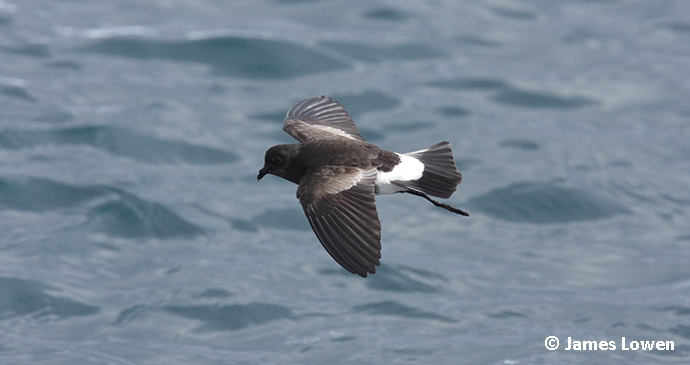
Wilson’s storm-petrels are unusual in Europe. Head to the Sagres Peninsula to spot one © James Lowen
The autumnal transformation in weather at the westernmost extremity of continental Europe is good news. Northwesterly gales have thrust pelagic birds close to land. Benign conditions mean that they are sitting on the sea – with you admiring them at close range from a RIB. The captain ladles a stinky feast on to the sea surface. Scores of famished seabirds are hyperactively circumnavigating the boat, plunging into the gloopy mess or tiptoeing delicately above it. The most numerous customer is Cory’s shearwater, Europe’s largest breeding ‘tubenose’. Prominent nostrils, covered by tubes on the upper bill, give it and other family members a refined sense of smell that enables them to detect chum from miles away. Among the Cory’s are striking seabirds with a white face and dark skullcap. The closest these great shearwaters breed is Tristan da Cunha. This is one of very few birds to breed in the Southern Hemisphere yet cross the Equator to winter. As the melée intensifies, so gannets pile in, dwarfing the other seabirds. A dusky shearwater proves to be a Balearic, a seabird declining so rapidly that it is considered Critically Endangered. Even the most optimistic research puts the total world population at just 25,000. There are more than a thousand times as many Wilson’s storm-petrels in the world, yet they are more unusual in a European context, as they breed on sub-antarctic islands. Among European storm-petrels pitter-pattering in the RIB’s wake, the skipper points out a Wilson’s – so close that you can see the lemon webbing separating its toes. What a pelagic!
Chania and Rethymno, Crete, Greece – for flora
Northwestern Europe in October. Summer’s bouquet is the faintest of scents in an olfactory memory bank. It is not merely hard-nosed botanists who crave spring’s floral resurgence. We mere mortals do, too. Flowering plants mean vibrancy, mean vitality, mean life. Help, fortunately, is at hand. Or, rather, at hand four hours flight away, in western Crete, at the opposite extremity of Europe.
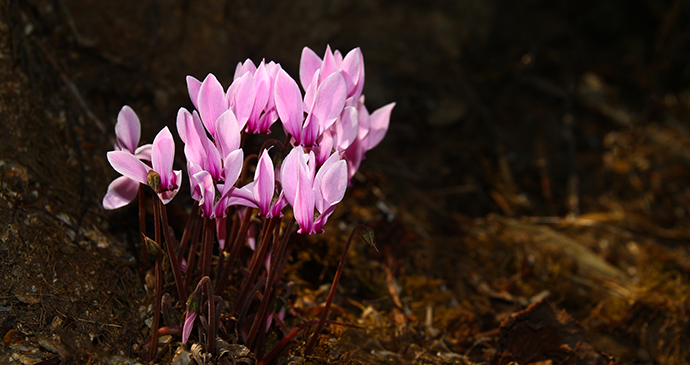
After an arid summer, Crete’s plants respond rapidly to the falling of their life source, flowering within days of the ground being dampened © Geza Farkas, Dreamstime
This autumn trip concerns cyclamens, crocuses and daffodils. The colours differ from those of spring; so too the textures, sizes, shapes. And that’s distinct enough an experience to chivvy you through the long, flower-free winter. Which blooms you muster – and particularly in what profusion – depends on how recently it has rained. After an arid summer, Crete’s plants respond rapidly to the falling of their life source, flowering within days of the ground being dampened. At ground level, you spot the delicate twirls of autumn lady’s-tresses – your final flourish of orchidelirium this year. The weekend’s first crocus, Crocus laevigatus, drips delicate lilac flowers that are boldly veined purple. It grows only in Crete. Another diminutive crocus, Colchicum pusillum, pockmarks the ground with pale pink, its petals long and narrow, the flower overall star-shaped. More common is the pretty little blue-and-white Solenopsis minuta and – at last a plant granted an English name! – the gloriously yellow autumn buttercup.
North Mallorca, Spain – for Ibiza wall lizard…
The Balearic’s largest island has a reputation for being the quintessential Club Med, bleeding badly behaved northern Europeans seeking cheap fun in neverending sun. But there’s another side to Mallorca – the real island – full of fabulous scenery and stippled with brilliant wildlife-watching locations that crave your attention.
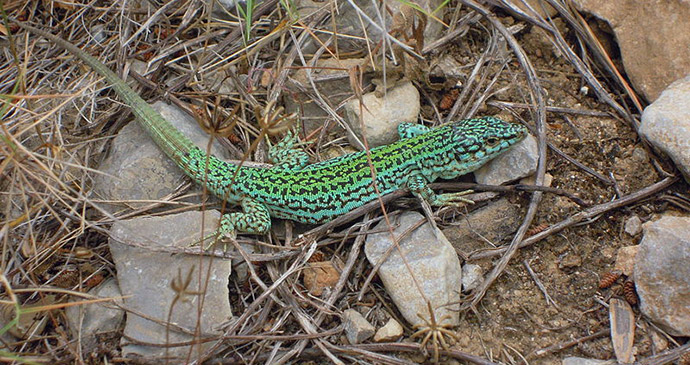
The Ibiza wall lizard is renowned for each insular population being a different colour © Stavros1, Wikimedia Commons
Given that your plane will arrive in Palma, Mallorca’s capital, start with a city-centre sightseeing trip. Flanking the Mediterranean, the Gothic cathedral of La Seu stands proudly, its nave higher than that of Notre Dame in Paris. At their base, the sacred walls offers safe haven for Moorish gecko and, notably, Ibiza wall lizard. As the latter’s name suggests, this reptile occurs naturally elsewhere amid the Balearic archipelago, but it has been introduced here. This robust lizard is renowned for each insular population being a different colour. There are green lizards and blue ones. And turquoise, orange and yellow as well as the more expected brown. Is this Darwin’s-finch-esque evolution happening, right in front of our tourist eyes?
… and Eleonora’s falcon
Traverse to Port de Pollença, then take the narrow, generously hair-pinned road northeast to Cap Formentor. Below the lighthouse, sandy-grey cliffs tumble and jag into the sea. This is the domain – the element – of Mallorca’s most famous bird of prey. Sharp, slender wings mark out the colonial, cliff-nesting Eleonora’s falcon from peregrines that also thrive here.
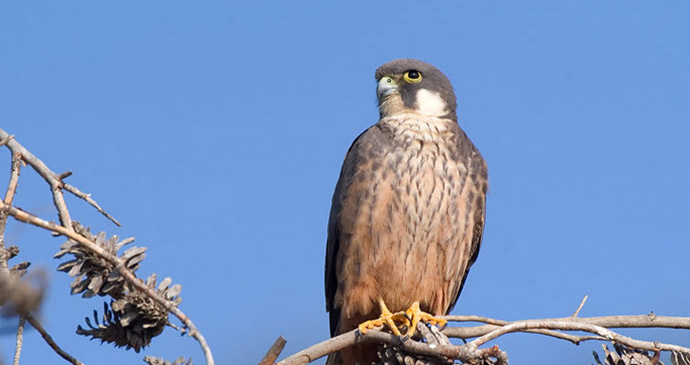
Sharp, slender wings mark out the colonial, cliff-nesting Eleonora’s falcon © Conselleria de Medi Ambient i Mobilitat, Govern des Illes Balears, Wikimedia Commons
Few Northern-Hemisphere birds breed as late as Eleonora’s, a characteristic interwoven with its equally unusual shift in diet. The falcon is routinely an insectivore, but – during its autumnal breeding season – switches to ‘harvesting’ migrant songbirds as they fly south for the winter. Making the most of this seasonal bounty, Eleonora’s falcon caches dead birds for later consumption. Remarkably, scientists recently discovered that the raptor also creates a living larder of imprisoned, immobile birds from which it has ripped both wings and tail. To see the falcon at its best, take a boat trip around Cap Formentor to Cala Sant Vicenç. Small groups swirl and scythe around the sea cliffs. One bird breaks off to dash out over the sea. Here, incredibly, it snatches an unsuspecting migrating warbler, its epic journey into Africa abruptly curtailed.
Aragón and Catalonia, Spain – for griffon vulture
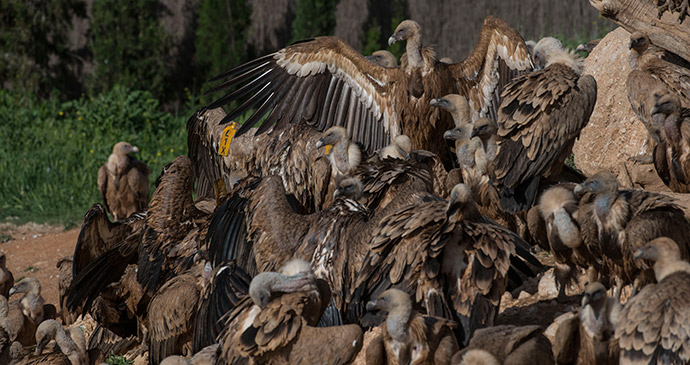
Up to 400 griffon vultures await their feed on Mas de Bunyol’s mounds of earth © Rob Williams
Feet stomp, wings raise, necks snake, eyes lock. Neither protagonist in this duel is backing down. There is one piece of meat, and both griffon vultures want it. A scuffle breaks out; sharp claws and mammoth beak are readied. Finally, one backs down, shuffling a return to the crowd of feather. The dust settles. Each morning, pastor de buitres (‘vulture priest’) José Ramón Moragrega heaves a wheelbarrow brimming with carcasses, off-cuts and offal into a chestnut-coloured arena flanked by tiring trees and backed by looming cliffs. Up to 400 griffon vultures have been waiting – increasingly restlessly following initial patience – on Mas de Bunyol’s mounds of earth. Now they descend in a flap of urgent wings and bounce across the ground towards Moragrega. He dumps scarlet meat on the ground, where it disappears beneath the stampede – and then vanishes completely as the famished birds gobble every last morsel. You and a score of fellow visitors gawp from your ringside seats in an observatory and two hides. Camera shutters machine-gun in exultation. Within half-an-hour, showtime is over. Vulture breakfasts are as brief and intense as they are messy and hectic. Little remains of the contents of Moragrega’s wheelbarrow. The odd feather tumbleweeds – the legacy of that vulturine skirmish.
County Cork, Ireland – for whale-watching
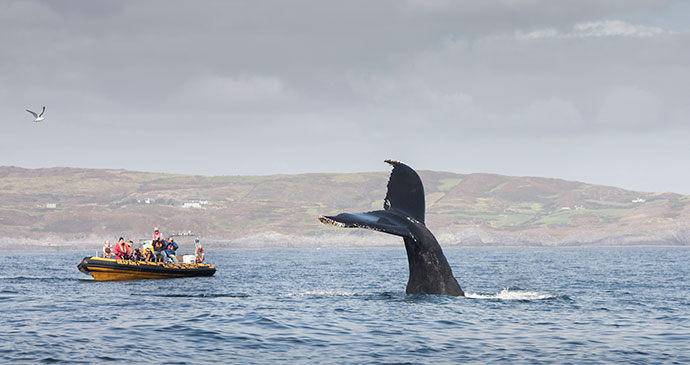
Autumn is the ideal season for whale-watching off County Cork © Baltimore Sea Safari
The leaden sea is barely riffled, the autumnal breeze insubstantial and the sky sombre – perfect conditions for whale-watching off County Cork. It should be just a matter of time – and sharp eyes.
‘Blow! Starboard! Halfway to the horizon!’
The ‘blow’ is the dense exhalation of water vapour from a surfacing cetacean, in this instance specifically a ‘rorqual’ or baleen whale. That the shimmering cloud is markedly taller than it is wide, columnar rather than mushroom-shaped, hints strongly at the breather’s identity. ‘Fin whale?’, someone ventures. As we approach, the blow appears again, and with it, the leviathan. Its back is the colour of unoxidised iron, rather than jet black. The dorsal fin is pronounced and pointed, rather than insignificant and lumpy. The animal rolls and rolls and rolls before slipping underwater without flirting its tail flukes. My fellow passenger is correct: this is a fin whale rather than a humpback. But whether she is right or wrong, this experience is magical. The skipper cuts the engine and we drift, giving the whale a couple of hundred metres berth. Every minute or two, it surfaces, exhales, rolls, and returns to watery concealment. Then it returns no more. It is gone – and rapidly too – plumbing the depths elsewhere. Not for nothing is the world’s second-largest creature nicknamed the ‘greyhound of the sea’.
Kikinda, Vojvodina, Serbia – for long-eared owls
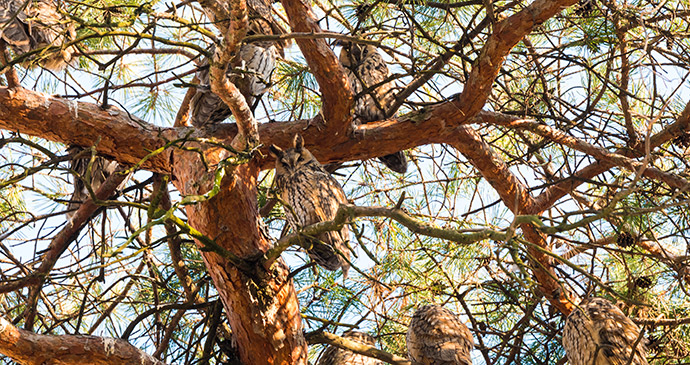
Northern Serbia is dotted with 400 long-eared owl roosts © David Lindo
We know of owls, but now it is time to get to know them. Very few owls roost communally and none is more gregarious than the long-eared. This is nowhere more true than northern Serbia, which is dotted with 400 separate roosts. On average, each slumber party contains 50 birds. Many are 250 strong, some exceed 400. Individual trees routinely hold 25 owls. And what owls they are. Although typically hunched at rest, when alarmed they become slender and erect. Ludicrously long ear-tufts (not ears, note) elongate the bird further. Combined with mottled, streaked and barred plumage in a palette of browns and buffs, this blends the bird with its chosen hideaway. And then there are embers for eyes, which make the owl look perpetually indignant. What an owl.
Discover more of Europe’s wildlife highlights in James Lowen’s 52 European Wildlife Weekends:
